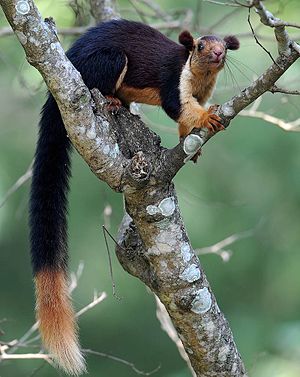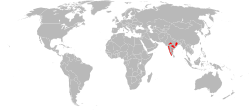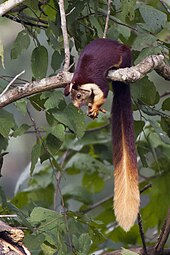King Giant Squirrel
| King Giant Squirrel | ||||||||||||
|---|---|---|---|---|---|---|---|---|---|---|---|---|

King's Giant Squirrel ( Ratufa indica maxima ) |
||||||||||||
| Systematics | ||||||||||||
|
||||||||||||
| Scientific name | ||||||||||||
| Ratufa indica | ||||||||||||
| ( Erxleben , 1777) |
The king's giant squirrel ( Ratufa indica ) is a type of giant squirrel (genus Ratufa ) within the squirrel (Sciuridae). It is one of the largest species of squirrel and is endemic to several subspecies in India .
features
With a body length of about 36 centimeters and a tail length of up to 45 centimeters and a weight of 1.5 to 1.8 kg, the king's giant squirrel is one of the largest representatives of the croissant . The fur is very colorful and variable in color. The color of the back can be red-brown, maroon or black, as well as the flanks, the head and the tail. The belly and the underside of the neck are white, the front legs cream-colored. There may be long black stripes on the thighs and lower legs. The head is brown or beige in color, and the insides of the ears are white, the nose is pink. The ears have conspicuous, red to chestnut-brown tufts of ears.
| 1 | · | 0 | · | 1 | · | 3 | = 20 |
Like all species of the genus has the type in the upper jaw half per one to a incisor tooth formed incisor (incisor) to which a tooth gap ( diastema follows). This is followed by a premolar and three molars . The teeth in the lower jaw correspond to those in the upper jaw. In total, the animals have a set of 20 teeth.
distribution and habitat
This species is found exclusively in the tropical forests of central and southern India .
Way of life
The diurnal species lives in the upper sections of the trees and is rarely found on the ground. The king giant squirrel lives solitary and feeds mainly on fruits, more rarely on leaves, flowers, seeds and bark. The leaf content of the food at times when there are few fruits is up to more than 60 percent, while it is close to zero percent in fruitful times. In the cloud forests of the Western Ghats, the animals were observed collecting nuts from six different tree species and a liana and building a supply in their nest in the treetops. Since most croissants stocking up do so on the ground, the behavior of the king squirrels in this case is unusual. The seeds were mainly hard-shelled seeds, including two types that the animals do not consume fresh. In some areas, such as in the Parambikulam Wildlife Sanctuary, the animals are primarily seed-eaters and feed on the seeds of ten different tree species.
Like many croissants, this type of croissant builds nests from twigs and leaves that they plant high in the treetops. The average population density is between 2.4 animals per square kilometer in Bandipur and 12.3 animals per square kilometer in Lakkavalli , but can be much higher regionally. The gestation period of the females is 2.5 months, the litter usually consists of one young.
Its natural enemies include numerous birds of prey and mammals . The successful capture of giant king squirrels by the bearded monkey ( Macaca silenus ), the leopard ( Panthera pardus ), marten, the Nepaluhu ( Bubo nipalensis ), the Malay eagle ( Ictinaetus malayensis ), the snake harrier ( Spilornis cheela ) and the crested eagle ( Nisa ). In regions with a large number of birds of prey, the animals spend the middle of the day in the nest in order not to be discovered. When fleeing from enemies, the squirrel can jump up to 6 m from tree to tree.
Systematics
The king's giant squirrel is classified as an independent species within the genus of the giant squirrel ( Ratufa ), which consists of four species. The first scientific description comes from the German natural scientist Johann Christian Polycarp Erxleben from 1777, who described the species as Sciurus indica using individuals from India.
Within the species, a total of four subspecies are distinguished using the nominate form :
- Ratufa indica indica : nominate form, lives in the Western Ghats south of the Indian capital Mumbai . The head and body are maroon, the tail ends in a light point.
- Ratufa indica centralis : in eastern and central India. The subspecies has red tufts of ears. The back, the flakes and the hind legs are red-brown, the front legs as well as the shoulders and the tail are black.
- Ratufa indica dealbata : In the Dangs region north of Mumbai. It is a very pale shape with a white tail. This subspecies is considered potentially extinct.
- Ratufa indica maxima : In the southwestern part of India to the southern tip. The subspecies corresponds to the nominate form, but is black on the shoulders as well as on the trunk and tail.
Existence and threat, protection
Although this species is still relatively common, it is threatened by the rapid destruction of its habitat, human settlements, logging and hunting. This species is legally protected in India. Dozens of reserves have been set up in the country, and it is also listed in Appendix II of the Washington Convention on Endangered Species.
supporting documents

- ↑ a b c d e f g h i Richard W. Thorington Jr. , John L. Koprowski, Michael A. Steele: Squirrels of the World. Johns Hopkins University Press, Baltimore MD 2012, ISBN 978-1-4214-0469-1 , pp. 26-28 .
- ^ Robert S. Hoffmann, Andrew T. Smith: Ratufa. In: Andrew T. Smith , Yan Xie: A Guide to the Mammals of China. Princeton University Press, Princeton NJ 2008, ISBN 978-0-691-09984-2 , p. 173.
- ↑ Hema Somanathan, Subhash Mali, Renee M. Borges: Arboreal larder-hoarding in the tropical Indian giant squirrel Ratufa indica. Ecoscience 14 (2), 2007; Pp. 165-169. doi : 10.2980 / 1195-6860 (2007) 14 [165: ALITTI] 2.0.CO; 2
- ↑ a b c Ratufa indica In: Don E. Wilson , DeeAnn M. Reeder (Ed.): Mammal Species of the World. A taxonomic and geographic Reference. 2 volumes. 3. Edition. Johns Hopkins University Press, Baltimore MD 2005, ISBN 0-8018-8221-4 .
- ↑ Ratufa indica in the Red List of Threatened Species of the IUCN 2015.1. Posted by: N. Rajamani, S. Molur, PO Nameer, 2010. Retrieved June 22, 2015.
- ^ William Thomas Blanford : The large Indian squirrel (Sciurus indicus erx.) And its local races or sub-species. Journal of the Bombay Natural History Society 11, 1898; Pp. 298-305.
literature
- Richard W. Thorington Jr. , John L. Koprowski, Michael A. Steele: Squirrels of the World. Johns Hopkins University Press, Baltimore MD 2012, ISBN 978-1-4214-0469-1 , pp. 26-28 .
- David Macdonald (Ed.): Encyclopedia of Mammals. Translation from English by Eva Dempewolf, Christiane Gsänger and others Könemann in the Tandem-Verlags-GmbH, Königswinter 2003, ISBN 3-89731-928-4 , pp. 598–609.
Web links
- Ratufa indica inthe IUCN Red List of Threatened Species 2015.1. Posted by: N. Rajamani, S. Molur, PO Nameer, 2010. Retrieved June 22, 2015.
- Pictures and videos of the king's giant squirrel at arkive.org

